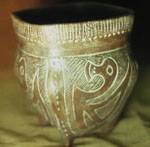North American Natives
Although North American native civilizations never achieved the level of sophistication of their South American neighbors, scholars speculate that cultural diffusion did take place between North and South American peoples, evidenced particularly in the use of common crops and ideas.
Hopewell

Hopewell pottery found at the Hopewell Culture National Historical Park in Ohio
The Hopewell civilization, sometimes known as Adena/Hopewell, lasted from about 200 BC to 400 AD. It was made up of communities that occupied much of the area now known as the American mid-west, along rivers in Ohio, Indiana, Illinois, Kentucky, and Tennessee. The Hopewell were part-time farmers who lived in villages. They constructed large burial mounds, from which archaeologists have unearthed a variety of objects that originated in distant areas from the Gulf Coast to the Great Lakes. The extensive trade networks developed by this culture stretched across the continent.
Mississippian
The Mississippian culture, which had a mound-building tradition, was in existence between about AD 1000-1540. The Mississippians lived primarily in the Mississippi Valley and the Southeast. The Mississippian civilization was made up of stationary farmers, who grew primarily corn, beans, and squash and sustained a deep connection with the land. Cahokia, the largest city and long-time capital of the Mississippian world, was located in the low plains where the Illinois and Missouri rivers flow into the Mississippi. Cahokia is estimated to have had a population of over 15,000 around the year 1100 A.D. Archaeological excavation of Mississippian sites reveal evidence of elaborate rituals and extensive trading. The Mississippian mound-builders perished over time from European diseases.
Mogollons
Web Field Trip
Learn more about the Mogollon people’s death and burial rituals.
The Mogollons inhabited the dry, mountainous areas of southern New Mexico and eastern Arizona. From 200 B.C. until about 1300 A.D. their culture flourished. This group developed homes that were designed to provide shelter in the harsh environment, complete with drainage systems sunk into the ground like large pits, which helped to keep the home’s inhabitants cool in the summer and warm in the winter. The Mogollons are best remembered for their delicate clay pottery, which formed an important part of their death and burial rituals. While the decline and disappearance of the Mogollons remains a mystery, the pottery they left behind provides insight into their belief system.
Hohokams
The Hohokams occupied the area of the Sonoran Desert of southern Arizona from about 300 A.D. to 1500 A.D, farming the floodplains of the Salt and Gila rivers. They built apartments into the ground, similar to those of the Mogollons. The Hohokams created far-reaching irrigation systems to move water to their crops. The villagers grew several types of beans and squash, in addition to cotton and corn. The Hohokams supplemented their diet by hunting and gathering in the mountains and desert. Hohokam culture produced pottery, baskets, and jewelry, and traded with other civilizations in the Southwest and Mexico. The rich Hohokam tradition also involved the construction of ball courts similar to those in Mesoamerica, and the ceremonial cremation of the dead.
Anasazi
The people known as the Anasazi, or Pueblos, occupied the four corners region (where the states of Colorado, New Mexico, Arizona, and Utah meet) establishing permanent homes from around 490 to 1300 A.D. The Anasazi diet consisted of gathered foods and hunted game, as well as garden corn, squash, and beans. The Anasazi culture is most often remembered for its kivas, which were underground ceremonial chambers. Communities lived in above-ground homes clustered around the kiva. Spanish explorers later called these dwellings pueblos. Anasazi culture included basket-making, gaming, gambling, and sporting events, often in connection with religious gatherings. To learn more about Native Americans in North America, click on the groups below.
Eastern Woodland People
The Eastern Woodlands were occupied by people from two large language groups, Algonquin and Iroquoian, who shared many economic and cultural patterns. Most of these cultures were semi-sedentary and practiced slash-and-burn agriculture, girdling trees to kill them, burning the underbrush, and planting primarily corn, beans and squash. Woman assumed most farming and household responsibilities while the men were hunters and warriors.
Before the Europeans arrival, the Iroquois or Haudenosaunee, as they identified themselves, had created a confederacy of five tribes (Mohawk, Cayuga, Seneca, Oneida, and Onondaga) known as the Great Law of Peace. The women of the tribes selected chiefs to attend the Grand Council where diplomacy replaced war among the tribes and enabled them to subdue enemies. They lived in longhouses, communal buildings sometimes as long as a hundred yards and as wide as sixty feet. Villages could have as many as sixty longhouses each with dozens of families.